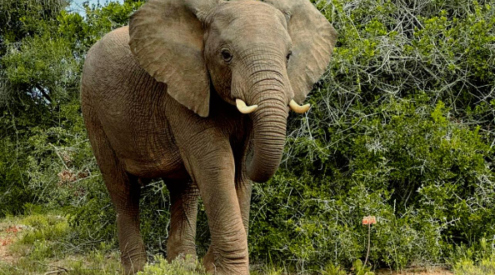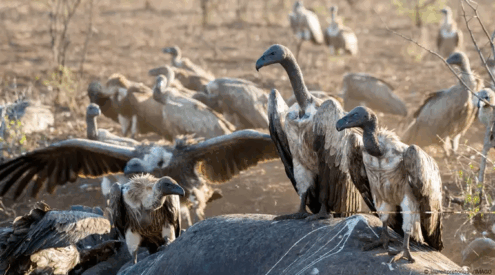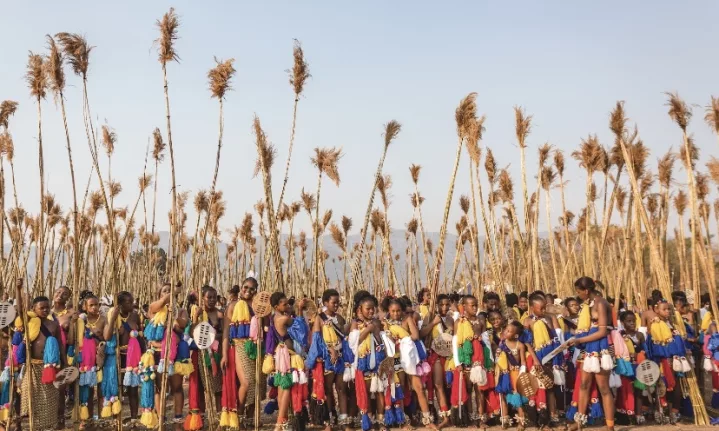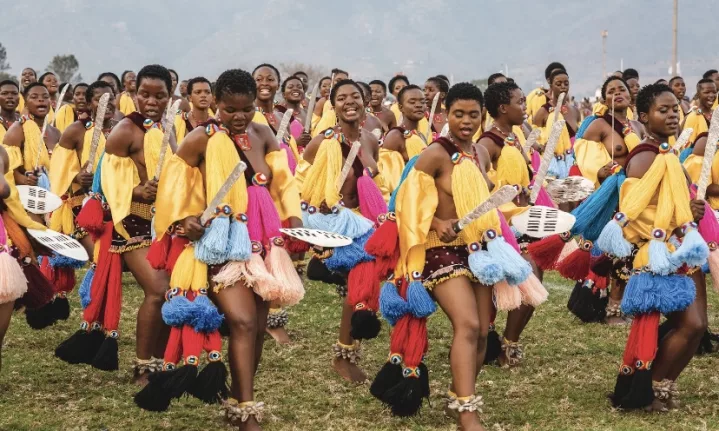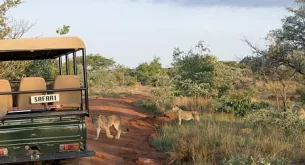Seeing thousands of young Swazi women and girls adorned in traditional attire streaming towards us is awe-inspiring and slightly surreal.
Their clothing is minimal: short, beaded skirts, rainbow-coloured scarves embellished with pompoms and tassels, and little else.
The girls chant and dance towards the queen mother’s residence, the rhythmical stamping of their feet and the jingling of their anklets vibrating in the air. Their energy is palpable and infectious.
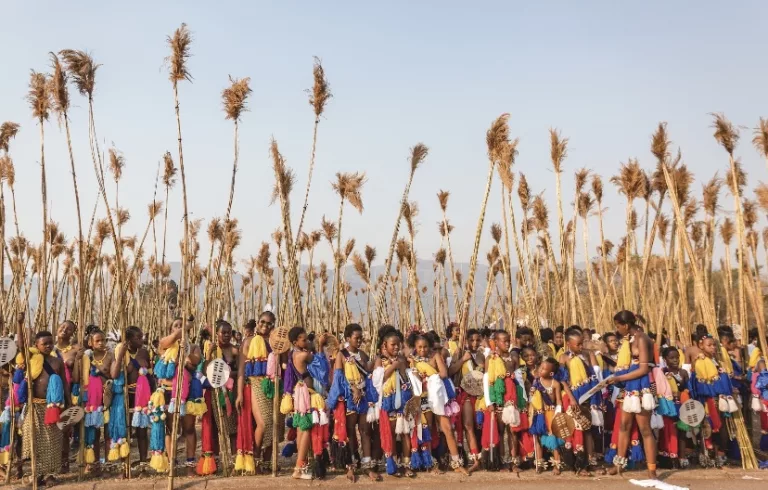
The Reed Dance, or Umhlanga, as it’s more widely known, is steeped in tradition and history. It dates back to the ’40s and is an adaptation of the older Nguni reed dance ceremony. Today, it serves as a rite of passage for young women and a way to honour the Queen Mother and the Swazi royal family. The ceremony involves strict protocols and customs and reflects the deep respect for tradition in Swazi culture.
Encircled by the giant geography of South Africa and Mozambique, the tiny landlocked country of Eswatini is 195 km long from north to south and 130 km from east to west, and with a population of only 1.2 million people, it’s Africa’s last absolute monarchy.
Eswatini considers itself a constitutional monarchy, but pro-democracy activists say that, in practice, it is an absolute monarchy, the last one in Africa and one of the only 12 remaining in the world. King Mswati III has ruled Eswatini for almost 38 years since taking over from his father, King Sobhuza II, who ruled the country for 82 years, the longest reign of any monarch in recorded history.
Approaching the King’s royal palace, we can see somewhere in the region of 40 000 costumed, singing girls, each carrying a bundle of freshly cut reeds. It is my first up-close encounter with the Reed Dance, and it’s already day six of the festivities. The Reed Dance is an eight-day spectacle, but things really come to life on the sixth day.
It’s early afternoon, and the women and girls referred to as imbali (flower or blossom) stand in about 200 groups called regiments, one from each Swazi chiefdom.
Only childless, unmarried girls, referred to as maidens, can take part. Aged anywhere from five to 25, they wait en masse for their turn to present their reeds to the Indlovukazi, a title roughly corresponding to Queen Mother but whose literal translation is Great She-Elephant.
The reeds are used to repair the guma (protective reed fence) around the Indlovukazi’s residence and are said to symbolise tribute, protection and the unity of the nation. I move among the groups of maidens, chatting. It’s a fascinating combination of the old and the new, the past and the present. When dressed in traditional costume, make-up, manicured nails, weaves and extensions are technically forbidden, though some ignore this rule and even take selfies.
The camaraderie is palpable; there’s laughter and playful teasing, and the chattier girls talk to me about the significance of their outfits. Beaded necklaces and rattling anklets made from cocoons, a mini skirt called an indlamu and a sash called an umgaco. The coloured tassels and woollen pompoms of the umgaco hold a special symbolic meaning, depending on the girl’s age and whether she is engaged or not, as do the feathers of the purple crested lourie or ligwalagwala, Eswatini’s national bird, that the girls wear as headdresses.
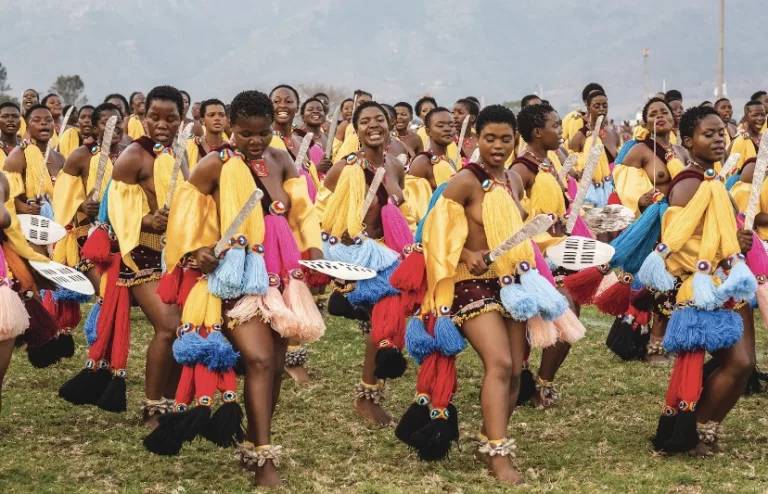
The Swazis believe these feathers bring good fortune, ward off evil spirits and protect against illness or harm. Some girls wear a whistle, and many carry the large knives they’ve used earlier to cut the reeds. These knives symbolise the girls’ virginity. The costumes vary slightly according to social status, and the girls from the royal family wear more elaborate outfits than the others. It’s been a busy few days, and many of them look exhausted as they move towards the arena, keeping to their regiments and marching into the stadium, each group singing a different song.
The maidens spent the first four days of the festival gathering in groups to cut and collect their reeds. The emphasis on tradition was evident. Older participants taught the young girls, for many of whom it was their first time, how to cut and carry the reeds correctly and perform the songs and dances.
The girls aged 14 and up had sometimes marched as far as 30 km to the reed beds, while those aged between eight and 13 had marched about 10 km. They cut the reeds from all over Eswatini, sometimes even as far away as Mozambique.
Once cut, they make a rope from plaited grass and tie between 10 and 20 reeds into a bundle before returning to Ludzidzini Royal Village. Over the past few days, I’ve seen hundreds of imbali standing in the back of cattle trucks and army lorries, singing and dancing as they’ve travelled the countryside. They’ve often brought the traffic to a complete standstill, as the imbali and their mission have priority over absolutely everything. I’ve even seen a whole market stop trading to watch and cheer for a group of passing girls proudly carrying their reeds aloft.
After four days of hard work and doubtless sleep deprivation, day five is the day to rest and prepare for the final celebrations. The girls use this day to wash and make final adjustments to their hair and costumes. There’s a fabulous party feel in the air of expectation and anticipation of something special on the horizon. On day six, they head to the Royal Residence for two days of celebration, and as the final days approach, their excitement grows.
Driving towards the royal palace, carefully avoiding stray goats, cattle, dogs and crowds making their way to the festivities, Eswatini suddenly becomes a hive of colourful activity.
A couple of my fellow travellers on the bus aren’t suitably attired, which annoys the driver. Given that the imbali march, sing and dance bare-breasted, you could be forgiven for thinking the dress code for observers is casual, but that’s not the case. There’s a strict dress code. Women must wear a skirt or a dress, and men must cover their legs with long trousers. We make a last-minute stop to purchase a traditional sarong called a emahiya. There are two choices: version one sports the Eswatini flag, while the other has a portrait of King Mswati III. Fifty Swazi lilangeni (R50) seems a small price to pay, and once we’ve finished shopping and everyone complies with the dress code, we carry on to the festivities.
We file into the grandstand at the parade ground, and nothing has prepared me for the sheer scale of the pageantry we’re about to witness. Column upon column of girls advances like vast ululating centipedes across the parade, each dissolving into the pulsating mass of bodies.
Up close, it is an almost overwhelming immersion in noise and colour as the girls stamp, sing and sway in unison, knives in one hand, shields in the other, anklets rattling, bare skin and dazzling costumes blurring into a living, chanting kaleidoscope.
Warriors dressed in animal skins and clutching knobkerries and shields escort the girls, sternly intent on their duties. The imbali, on the other hand, are all smiles. It’s Eswatini’s biggest holiday, and they’re determined to party after days of marching, cutting reeds and camping out.
The King and Queen Mother preside over the event, and the sight of the King, dressed in traditional regalia and addressing the crowds, is a reminder of the monarchy’s role in Swazi culture.
The King’s speech, delivered in siSwati, is met with cheers and applause, and as he strides into the crowds, followed by his warriors, to inspect the regiments, the festivities draw to a close. All that remains is for the King to order the slaughter of 20–25 cows the following day, and each girl will collect a piece of meat to take home.
I’d never have imagined one festival could encapsulate so much of a country’s cultural essence until I attended the Reed Dance. The Umhlanga isn’t just about marching or dancing or singing; it’s a reaffirmation of cultural values, a vibrant display of community spirit, a way of preserving cultural knowledge and transmitting it to future generations and a living, breathing expression of Swazi identity. As the festival ended, all the sights, sounds and experiences blended into an unforgettable memory. Eswatini’s Reed Dance demonstrates the beauty of a nation’s heritage and its people’s warmth and resilience.
Trip planner
The Reed Dance or Umhlanga usually happens in the last week of August or the first week of September. In 2024, the main days of the festival are 1 and 2 September.
There is not much in the way of visitor arrangements – a special grandstand accommodates visiting dignitaries – but turn up at Ludzidzini and follow the crowds (Day 7 is the liveliest day). Police will direct you where to go and where to park.
Where to stay

Mogi Boutique Hotel
There are plenty of places to stay in Eswatini. The country is so small, you can stay pretty much anywhere and still make it to the Reed Dance, but a few options to try are Mogi Boutique Hotel , Mantenga Lodge and The Royal Villas
Nudity, Photography and Social Media
The Reed Dance videos were once classified as age-restricted content by YouTube, which angered users who had uploaded them.
That included Lazi Dlamini, the head of TV Yabantu, an online video production company that aims to produce content that ‘protects, preserves and restores African values’.
Working with 200+ cultural groups, Lazi organised a series of protests against Google to force them to rethink their position. YouTube apologised and allowed the showing of genuine African traditional videos. According to a representative for the company, they lifted the restriction, as it is not Google’s policy to ‘restrict nudity in such instances where it is culturally or traditionally appropriate’.
Facebook and Instagram prohibit sharing ‘revealing’ photographs of the Reed Dance, and festival organisers have also clamped down on journalists at the ceremony, imposing strict accreditation checks to, provincial spokesperson Mandla Msibi says, ‘protect the maidens from being exploited’.
Not all aspects of the Reed Dance are without controversy. The festival, rooted in traditions of chastity and virginity, has faced criticism.
Families who do not send their daughters receive fines and conditions for the participants can be challenging, especially for those not used to roughing it. Traditionally, the King chooses a new wife from among the dancers, though the last time he did this was in 2013. (King Mswati III reportedly has 15 wives and 35 children).
In my experience of the Reed Dance, all the girls I spoke to were excited to be there at the event and were swept up in the excitement. Most were there for the third or fourth time.
This article was written by Sarah Kingdom for Getaway’s September 2024 print edition. Find us on shelves for more!
Pictures: Courtesy Images
Follow us on social media for more travel news, inspiration, and guides. You can also tag us to be featured.
TikTok | Instagram | Facebook | Twitter
ALSO READ: Tunisia: the jewel of the North


